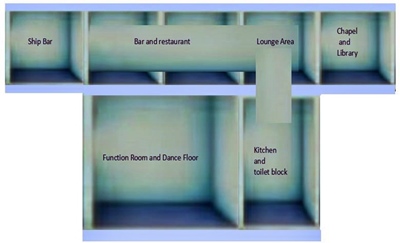Several forts were built around the coastline to protect England from the French.

When the Stanhope Committee reviewed the country's defenses in 1887 it was deemed to have been possible for enemy warships to anchor in the Bay to the rear of Anthony position which previously had been thought to have been guarded sufficiently by Polhawn Battery on the Rame Peninsula however it was realized that with the advances in naval artillery over the years that ships anchored in the bay from that position at 8,000 yards range would be able to bombard Plymouths Dockyard without being threatened by the existing forts.
To counter act this threat Whitsand Bay Battery were proposed in 1885 to be built on land south of Stone Farm at the top of Tregonhawke cliffs just 600 yards south of the impressive Tregantle Fort and was built with defenses resembling a Fort rather than a Battery (a Fort is a fortified building or strategic position, where as a Battery is a fortified emplacement for heavy guns) strongly fortified against land attack with a rock cut dry moat and protected by 3 x octagonal concrete caponiers (blockhouses) for machine guns. It was designed and built to mount 3 x 12.5-inch Rifle Muzzled.
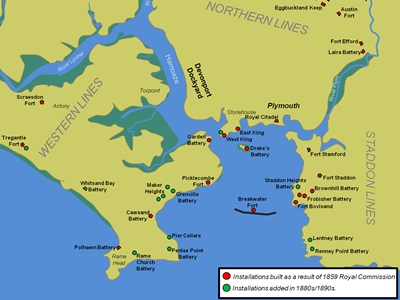
The chain of forts around Plymouth as proposed by Palmerston in the 1860s. They include Tregantle and Scraesdon in the west and both remain in military use. Polhawn – a popular wedding venue and Cawsand – now residential accommodation, cutting of the Rame Peninsula, and Garden Battery – part of the Mount Edgecombe estate and Picklecombe – now a residential complex, positioned at Mount Edgcumbe.
Loader guns along with 6 x 10-inch Breech Loader Howitzer (the Howitzer is characterized by a relatively short barrel and the use of comparatively small propellant charges to propel projectiles in relatively high trajectories, with a steep angle of descent) guns.

Shown pictured above is a 12.5-inch Riffle Muzzle Loader 38-ton gun being loaded and fired by a crew of 10 men.
In 1887 the Stanhope Committee re-considered the armament, and it was amended to 3 x 12.5-inch R.M.L - Rifled Muzzle Loader guns weighing a heavy 38 tons; large, rifled muzzle -loading guns designed for British battleships and also employed for coastal defenses.
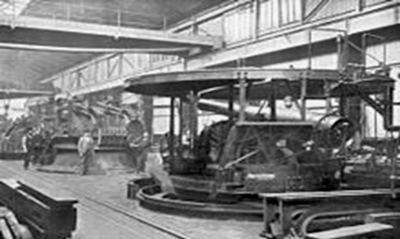
Mk IV or VI gun on disappearing mounting under construction at the Royal Carriage Factory, Woolwich, 1890s.
A muzzle loading weapon is loaded through the muzzle, or front of the barrel. Able to fire a projectile of 800 pounds with a charge of 130 pounds of P2 gunpowder without undue strain over a range of 6000 yards and each gun would have been served by 10 men, along with 2 x 6-inch B.L H. P - A breech-loading gun is a firearm in which the cartridge or shell is inserted or loaded into a chamber integral to the rear portion of a barrel, much quicker to load, and allowed emplacements to be smaller. Hydro-Pneumatic disappearing carriages allowed the smaller guns to be raised, fired and dropped out of enemy site. Weighing 5 tons - barrel and breech, and able to deposit a 100 lb. projectile with a maximum firing range of 10,000 yards. This weapon commonly became referred to as "6-in 5-ton B.L.R."

Detailed diagram of 6-inch B.L H. P and 6-inch B.L H. P gun.
The shells for the guns were stored 15 feet underground and raised up on the crank hoist below in the magazines. The guns were in place and ready for action by 1893 and removed in 1897.
1904 Fort records lists 2 x 6-inch B. Ls on Naval Slide mounts and probably used for practice purposes. Then in 1918 armament lists listed 3 x R.M. Ls as mounted but as surplus and removed after 1920. During World War II the site was used for a radar station, as part of the Coast Artillery Training Centre, Plymouth and air raid shelter for the local civilians.
On the southwest edge of the battery the practise battery was constructed which is still visible today. The chalets on the cliffs were used to house evacuees from the heavy bombardment of Plymouth during early 1941 but as these were a fire hazard people sort shelter down in the magazines as German planes flew overhead bombarding and decimating Plymouth during the Blitz.
1951 the Military released the Battery and its preservation lay as becoming home to Whitsand Bay Fort Holiday Park, where luxury chalets cover the Fort, with peaceful views across the Tamar to Plymouth and across the Bay. Tranquil camping pitches surround the gun emplacements and magazines. What were once the Mess and living quarters for 40 men now offers comfortable seating, quaint bar, restaurant and a Chapel and library, other facilities include a swimming pool, gym and hot tubs provide additional amenities for relaxing guests.
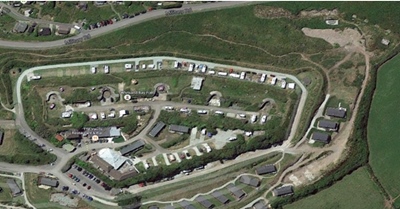
Above is an aerial view of Whitsand Bay Fort Holiday Park clearly showing the Forts emplacements, ditch, caponiers, living quarters and roads as still seen today. The practise Battery remains are to the top right.
Although the dry ditch has been filled-in many of the original features can still be seen such as theA3 x 12.5-inch RML and B2 x 6-inch BLHP emplacements still survive with their magazines beneath, and the Ccaponiers at the SW and NE angles are also visible although the ditch has been filled in. Some of the glacis (gently sloping bank, in particular one that slopes down from a fort, exposing attackers to the defenders' missiles), has been re-profiled.
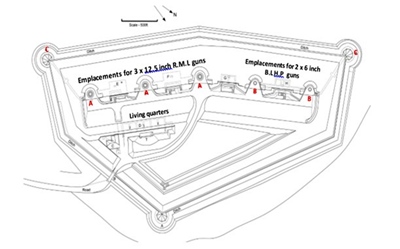
A clear diagram of the Fort indicating the gun emplacement, magazines, caponiers and living quarters, ditch, and roads.
Whitsand Bay Fort Schematics
The Tunnel/Magazine

The Vaults – once living quarters.
